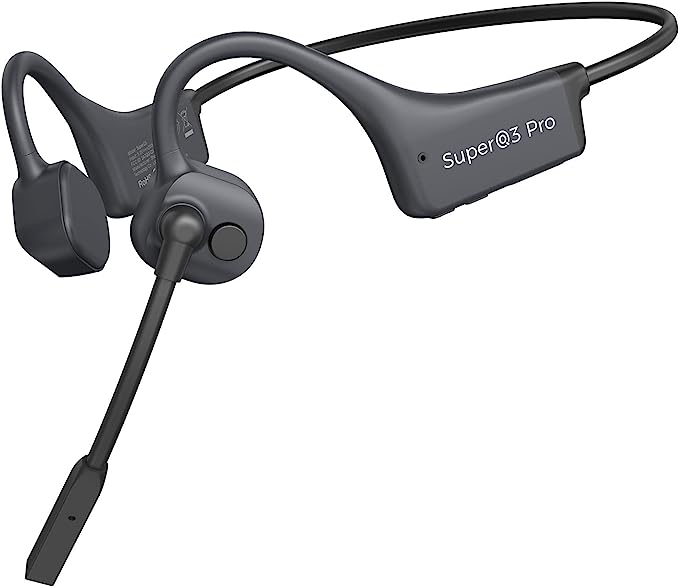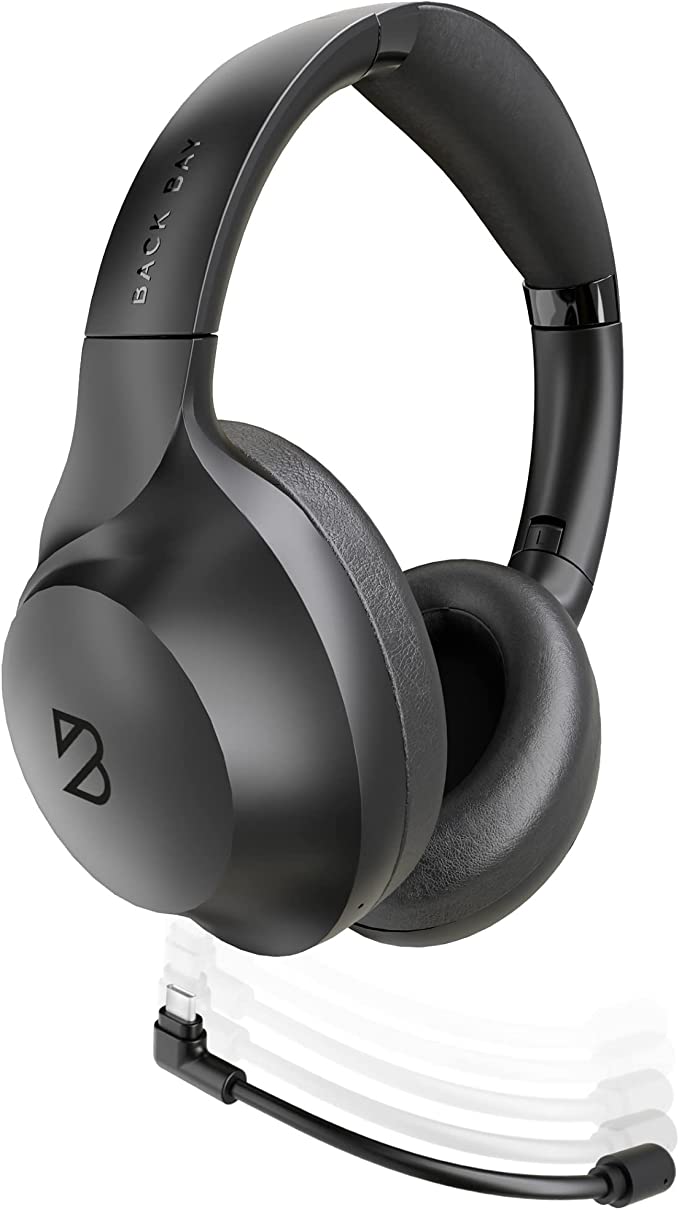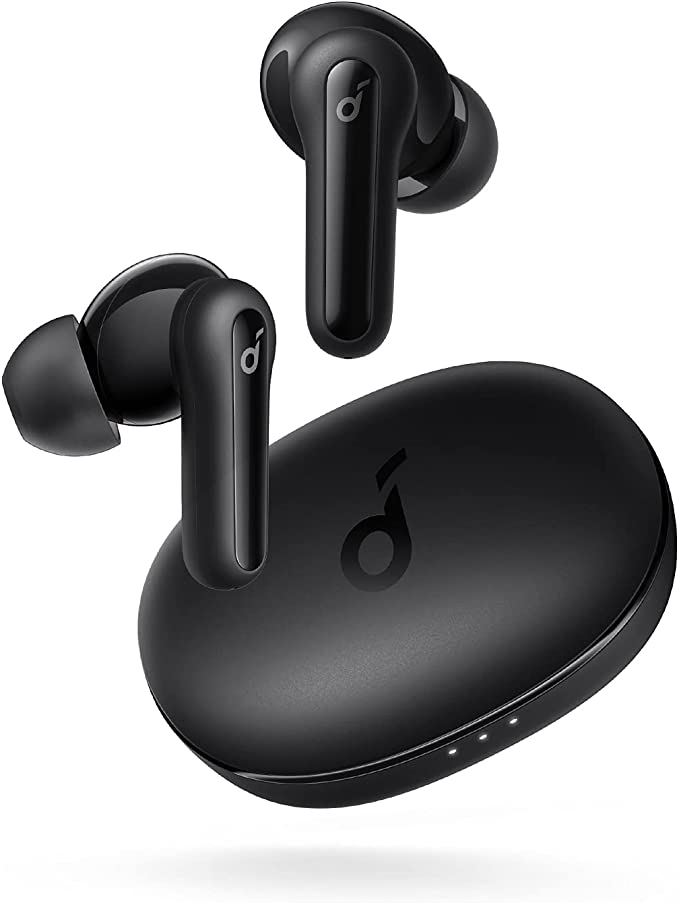Dytole DY101 Trucker Wireless Headset: The Deep Science Behind Clear Calls and Lasting Comfort
Update on Sept. 24, 2025, 4:03 a.m.
Our world is getting louder. From the relentless symphony of city traffic and the cacophony of open-plan offices to the surprisingly distracting hum of a home filled with online classes and remote work, true auditory peace feels like an increasingly scarce commodity. This constant barrage of noise doesn’t just chip away at our concentration; it frays our nerves, hampers clear communication, and can even subtly degrade our quality of life. In such an environment, is the ability to connect, to hear and be heard with crystalline clarity, becoming a luxury? Or can technology offer us a portable sanctuary, a personal haven of quiet in the midst of the storm?
Enter devices like the Dytole DY101 Trucker Wireless Headset. It’s more than just an accessory; it’s a promise – a promise to carve out a pocket of clarity, to ensure your voice, and only your voice, cuts through the din. But how does a piece of headgear achieve this? It’s not magic, but a fascinating blend of acoustics, artificial intelligence, and engineering, all working in concert to fight the unseen battle against noise. Let’s delve into the science that makes such focused sound possible.
The Alchemists of Audio: How AI Filters Your World’s Cacophony
Imagine you’re on a crucial call, perhaps a truck driver navigating a storm-lashed highway, needing to hear dispatch clearly. With a headset like the Dytole DY101, the person on the other end hears your voice with remarkable clarity, as if the roaring wind and pelting rain around you have momentarily ceased to exist. This is the work of Environmental Noise Cancellation (ENC), often supercharged with Artificial Intelligence.
It’s important to distinguish ENC from its cousin, Active Noise Cancellation (ANC). While ANC primarily focuses on improving the listening experience for the wearer by creating “anti-noise” to cancel out ambient sounds reaching their ears, ENC is predominantly about cleaning up the audio sent by the microphone. Its goal is to ensure the person on the other end of the call hears you, not your environment. The Dytole DY101 leverages this ENC, with the company claiming its “intelligent AI algorithm” can eliminate “99% of disturbances like traffic noise, wind noise, piercing noises, and background music” (Source: Amazon product page).
But how does this “AI alchemy” actually work? It’s a sophisticated process:
- The Sound Catcher: It typically starts with one or more microphones strategically placed on the headset. These microphones pick up all sounds – your voice and the surrounding environmental noise.
- The Brains of the Operation – DSP & AI: This is where the Digital Signal Processor (DSP) chip and the AI algorithms come into play. The DSP is the powerful mini-computer that digitizes the captured analog audio signals. Then, the AI, often a neural network trained on vast libraries of speech and noise, gets to work. It’s like an incredibly skilled sound engineer, capable of distinguishing the unique “fingerprint” of human speech from the chaotic patterns of, say, a diesel engine or a crowded café. It analyzes the incoming audio in real-time, identifying which parts are your voice and which parts are unwanted noise.
- The “Noise Eraser” at Work: Once the AI has identified the noise, it can employ several techniques. One common method in ENC is to use algorithms to isolate and suppress the noise frequencies while allowing the voice frequencies to pass through more clearly. For the “99% elimination” claim, it’s likely a combination of sophisticated filtering and potentially some form of targeted “anti-noise” generation specifically for the microphone’s input, ensuring only your purified voice is transmitted.
Think of it like this: your voice is a VIP, and the AI is an astute bouncer at an exclusive club, expertly identifying and turning away the rowdy, unwanted noise crowd trying to get in, ensuring only the VIP (your voice) makes it through the microphone to the listener.
The real-world implications are profound. For a truck driver like “Old Wang” (a hypothetical user), caught in a sudden downpour on a busy interstate, clear communication with dispatch via his DY101 isn’t just convenient; it’s a matter of safety, ensuring he receives critical instructions without ambiguity. However, it’s worth pondering the limits. Can AI noise cancellation be too effective? Could it filter out crucial environmental cues, like an emergency siren, if not perfectly tuned? The pursuit of silence must always be balanced with awareness.
The Invisible Bridge: How Bluetooth 5.2 Weaves Stable, Efficient Connections
You pair your Dytole DY101 with your phone or laptop, and it just…works. Music streams flawlessly, calls are stable, and you can even connect to two devices at once, seamlessly switching between them. This seemingly effortless connection is largely thanks to Bluetooth 5.2, the wireless standard working tirelessly behind the scenes.
Bluetooth technology has come a long way since its inception in the late 1990s, named, rather whimsically, after the 10th-century Danish King Harald “Bluetooth” Gormsson, famed for uniting Danish tribes. Bluetooth 5.2, one of its more recent iterations, brings several key enhancements over its predecessors, all vital for a good wireless audio experience:
- Enhanced Data Throughput & Stability: While not always directly translating to “faster speeds” in a way a user might perceive for audio (which has specific bitrate needs), Bluetooth 5.2 offers features like Enhanced Attribute Protocol (EATT) which can improve the responsiveness and reliability of connections, especially in congested radio environments. It’s better at navigating the busy 2.4 GHz frequency band it shares with Wi-Fi and other devices, using sophisticated frequency-hopping techniques to avoid interference.
- Improved Power Efficiency: This is a big one for battery-powered devices like headsets. Bluetooth 5.2 incorporates features from Bluetooth Low Energy (BLE), including advancements in how devices “sleep” and “wake” to transmit data, significantly reducing overall power consumption. This is a key contributor to the impressive battery lives we see in modern wireless gear.
- Support for LE Audio (Potentially): Bluetooth 5.2 is a prerequisite for LE Audio, a newer generation of Bluetooth audio that promises, among other things, the high-quality, low-power LC3 codec, and features like Auracast™ broadcast audio. While the Dytole product page doesn’t explicitly state LE Audio support, the underlying Bluetooth 5.2 capability opens the door for devices to implement these more advanced audio features.
One of the standout conveniences of the DY101, as highlighted on its product page, is the ability to “seamlessly connect two devices simultaneously.” This is known as Bluetooth Multipoint. Imagine our office professional, “Lisa,” in a video conference on her laptop, her DY101 also paired with her smartphone. An important client calls her mobile. With a simple button press on the headset, she can pause the laptop audio and take the call, then switch back just as easily. This “magic” involves the headset maintaining active B信道 (Bluetooth communication channels) with both source devices, intelligently managing which audio stream takes priority based on user input or incoming signals. It’s like having two invisible tethers, allowing you to effortlessly juggle your digital life.
The future of wireless connection, with Bluetooth at its core, is exciting. As we move towards an even more interconnected world, the reliability, efficiency, and versatility of standards like Bluetooth 5.2 will only become more crucial.
Escaping the Leash: Where Lies the Boundary of “164 Feet” of Freedom?
Wireless technology gifts us freedom from tangled cables, allowing us to roam. The Dytole DY101 product information states a wireless range of “up to 49 feet/15 meters” in typical conditions, impressively extending “up to 164 feet/50 meters without obstructions” specifically for truckers. But what dictates this invisible boundary, and how “real” are these numbers?
Radio waves, which carry Bluetooth signals, are a form of electromagnetic radiation, much like visible light or Wi-Fi signals. They travel through space, but their journey isn’t always unimpeded. Several factors determine how far a Bluetooth signal can reliably travel:
- Bluetooth Power Class: Bluetooth devices are categorized into different power classes. Class 1 devices, often used in industrial applications or some long-range dongles, can theoretically transmit up to 100 meters (about 328 feet). Class 2 devices, common in mobile phones and headsets, typically have a range of around 10 meters (about 33 feet). Class 3 devices are shorter-range, around 1 meter. The DY101’s claimed 50-meter range suggests it might be operating at a higher power output than a typical Class 2 device, or has a particularly efficient antenna design, especially when paired with a potentially more powerful transmitter in a truck’s system or a dedicated dongle.
- “Without Obstructions” is Key: The “164 feet/50 meters” figure is an ideal scenario – a clear line of sight between the headset and the transmitting device. In the real world, every wall, piece of furniture, metal object, and even the human body can absorb, reflect, or refract radio waves, a phenomenon known as attenuation. This weakens the signal, reducing effective range. Even other devices operating in the crowded 2.4 GHz band (like Wi-Fi routers, microwaves, or other Bluetooth devices) can cause interference, further limiting range and stability.
- Antenna Design: The design and placement of the antenna within both the headset and the transmitting device are crucial. A well-designed antenna maximizes signal transmission and reception efficiency.
So, while 164 feet is an impressive number, it’s the “best-case” scenario. For “Li,” our hypothetical warehouse administrator, this extended range means he can move between aisles, checking inventory, while staying connected to his colleague via the DY101, significantly boosting his workflow. But if he moves behind a thick concrete wall or a large metal shelving unit, he might find that “freedom boundary” shrinks considerably. The pursuit of greater wireless range always involves a trade-off with power consumption and the physical realities of radio wave propagation.
The Secret to Unflagging Stamina: Where Does 65 Hours of Power Originate?
A wireless headset with all the bells and whistles is of little use if its battery dies halfway through your workday or long-haul journey. The Dytole DY101 boasts an impressive “up to 65 hours of working time on a single charge of just 2 hours” (Source: Amazon product page). What’s the science behind this remarkable endurance?
It’s a combination of several factors:
- The Heart of the Matter – Lithium-Ion Batteries: Modern portable electronics overwhelmingly rely on lithium-ion (Li-ion) or lithium-polymer (Li-Po) batteries. These marvels of electrochemistry offer high energy density, meaning they can pack a lot of power into a relatively small and lightweight package. Inside the battery, lithium ions shuttle between a positive electrode (cathode) and a negative electrode (anode) through an electrolyte during charge and discharge cycles, creating an electrical current. The specific chemistry and physical design of the battery cell determine its capacity, typically measured in milliampere-hours (mAh). A higher mAh rating generally means more energy storage.
- Bluetooth 5.2 – The Thrifty Communicator: As mentioned earlier, Bluetooth 5.2 is designed with power efficiency in mind. Its Low Energy (LE) aspects allow the radio to spend more time in low-power sleep states, waking up only for brief data transmissions. This “sipping” of power, rather than continuous “gulping,” dramatically extends battery life, especially for devices that aren’t constantly streaming high-bitrate audio.
- Intelligent Power Management: Beyond the battery cell and Bluetooth chip, the headset itself contains a Power Management Unit (PMU). This is a sophisticated integrated circuit that acts like a smart energy accountant. It optimizes power distribution to different components (DSP, amplifier, LEDs, etc.), regulates charging to protect the battery, and often implements various power-saving modes when the headset is idle or in standby.
- Usage Patterns Matter: The “65 hours” figure is an “up to” claim, likely achieved under specific test conditions – perhaps moderate volume, a certain ratio of talk time to standby time, and with certain features (like extremely aggressive noise cancellation, if it were a user-selectable option) possibly disabled or optimized. Constant high-volume audio streaming or very long, continuous talk times in noisy environments (requiring more processing for ENC) will naturally consume more power and reduce the actual working time.
For “David,” our long-haul trucker, this 65-hour capability means peace of mind. He can charge his DY101 once and have it reliably serve him for days, whether he’s listening to navigation prompts, chatting with family during breaks, or catching up on podcasts. It eliminates the “battery anxiety” that can plague users of less power-efficient wireless devices. The quest for longer battery life continues to drive innovation in battery chemistry, low-power electronics, and smart energy management, all aiming to keep us connected for longer, with less tethering to a charging cable.
The ‘First-Class Cabin’ for Your Ears: When Technology Meets Ergonomics and Material Science
All the advanced technology packed into a headset is rendered moot if wearing it for extended periods feels like a medieval torture device. Comfort is paramount, especially for users like truckers or remote workers who might wear their headsets for many hours straight. The Dytole DY101, according to its description, aims for all-day comfort with an “Over Ear” design, “ultra-soft protein leather earcups,” and “memory foam padding.”
Let’s break down the science of this comfort:
- Over-Ear (Circumaural) Design: This style, where the earcups completely encircle the ears, offers several advantages. Acoustically, it creates a better seal, which helps with passive noise isolation (blocking out some external sound simply by covering the ears) and can improve the perceived bass response. Comfort-wise, it distributes pressure around the ear (on the side of the head) rather than directly on the sensitive cartilage of the ear itself, which is common with on-ear (supra-aural) designs and can lead to soreness more quickly.
- Protein Leather – The Skin-Friendly Impostor: “Protein leather” is a type of synthetic leather, typically made from a polyurethane (PU) base combined with protein powder (sometimes from eggshells or other sources, though formulations vary). It’s designed to mimic the softness, breathability, and feel of genuine leather but often boasts better durability, easier cleaning, and more consistent quality, usually at a lower cost. For earcups, a soft, pliable material is crucial to avoid irritation during prolonged skin contact.
- Memory Foam – The Custom-Fit Cushion: Memory foam, or viscoelastic polyurethane foam, is an amazing material. Its defining characteristic is its slow recovery rate after compression. When you press it, it yields and conforms to the shape, and when the pressure is removed, it slowly returns to its original form. In earcups, this means the foam molds to the unique contours of the area around your ears, distributing pressure evenly and reducing specific pressure points. This custom fit not only enhances comfort but also improves the acoustic seal.
- Adjustability is Key: The DY101 also features a 270-degree rotatable microphone and an adjustable headband. These elements are vital for ergonomics. The ability to position the microphone optimally for voice pickup on either ear caters to individual preference and can improve call clarity. An adjustable headband ensures the headset can fit various head sizes securely but without excessive clamping force.
However, comfort remains a highly subjective experience. As the Amazon reviewer “Robin” noted in the provided product information, while she found the headset became more comfortable over time, she did experience some tightness and a headache after very prolonged (6+ hours) wear, particularly finding the earcup large for her smaller ears. This highlights that even with thoughtful material choices and design, individual factors like head shape, ear size, sensitivity to pressure, and even hairstyle can influence long-term comfort. No single design can be a perfect “one-size-fits-all.” The ideal is a design that offers enough adjustability and well-chosen materials to suit the majority of users for their intended duration of use.
For “Zhang,” our hypothetical work-from-home programmer, the ergonomic design of his DY101 means he can get through hours of coding and back-to-back online meetings without the constant distraction of ear discomfort, allowing him to stay focused and productive. The ongoing challenge for headset designers is to continue refining this delicate balance of acoustic performance, feature integration, and long-lasting, almost unnoticeable, comfort.
The Guardian of Your Voice, The Enabler of Connection: How Technology Makes Our World Sound Better
The Dytole DY101 Trucker Wireless Headset, when we peel back its plastic shell and marketing claims, serves as a fascinating microcosm of how diverse scientific and engineering disciplines converge to solve very human problems. From the sophisticated algorithms of Artificial Intelligence battling ambient noise, and the intricate radio frequency engineering of Bluetooth 5.2 forging stable connections, to the material science delivering hours of comfortable wear and the electrochemical marvels powering it all – each element plays a crucial role.
For the truck driver navigating a continent, the remote worker collaborating across time zones, or anyone simply trying to have a clear conversation in our increasingly noisy world, such technologies offer more than just features; they offer clarity, focus, freedom, and a sense of connection. This isn’t merely about a single headset; it’s a testament to the relentless human endeavor to overcome physical barriers and enhance our ability to communicate and interact effectively.
As we look to the future, the evolution of audio technology promises even more seamless, intelligent, and personalized experiences. Imagine headsets that not only cancel noise but also subtly enhance desired sounds, or that integrate biometric sensors to monitor well-being, or that offer truly three-dimensional audio for immersive collaboration. Our quest for better sound, for clearer communication, is a journey without end, and it’s a journey that makes our world, in many ways, a more “listenable” and connected place.

































